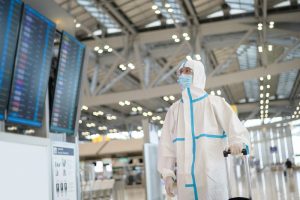The Occupational Safety and Health Administration (OSHA) is a federal agency that regulates safety for the workplace.
One of its responsibilities is to make sure employers abide by occupational health and safety laws and regulations. Their main method of checking for compliance is to conduct an inspection.
Each inspection has distinct stages and a purpose behind those stages. But, what are the four stages of an OSHA inspection?
- the credential presentation;
- the opening conference;
- the walkaround; and
- the closing conference.
These four stages will be discussed in detail below so that you know exactly what to expect when an OSHA inspection is carried out at your workplace.
What Triggers a Workplace Safety Investigation?
The Occupational Safety and Health Administration has a team of compliance safety and health officers dedicated to conducting workplace inspections throughout the year.
An OSHA inspection can be triggered in several instances, including:
- employee complaints about occupational safety violations;
- imminent dangers; and
- accidents that result in severe injury or death with an inspection.

Depending on the trigger, an OSHA compliance officer will conduct one of four inspections:
- Employee Complaint Inspections: employees or their representatives are entitled to complain about a safety or health hazard in the workplace.
- Imminent Danger Inspections: if there is reasonable certainty that an imminent danger exists at the workplace that could cause physical harm or death, an OSHA inspection will take place within 24 hours of lodged complaint. So, these take top priority out of the four types of inspections.
- Programmed Inspections: there are specific OSHA selected industries requiring their employees to undertake dangerous or hazardous work, so OSHA usually conducts random inspections at target selection workplaces to reduce the amount of hazard or danger.
- Fatality and Accident Inspections: if a fatality has occurred at the workplace, the employer must report it to OSHA within eight hours of the incident occurring – after which a compliance officer will inspect to establish whether or not the employer was at fault for the accident.
Usually, after each initial inspection, the OSHA compliance will return for a follow-up inspection.
So, What Are the Four Major Stages of an OSHA Inspection?
Once a complaint or incident has been reported, you’ll need to prepare for the inspection.
Other than imminent danger inspections, you can expect a compliance officer to arrive within 30 days of the complaint or incident.
Stage 1: Presenting OSHA Credentials
When arriving at the workplace, the compliance office will establish who is in charge to present their Occupational Safety and Health Administration credentials.
At this stage, an employer is legally allowed to request the OSHA compliance office to get a warrant before the inspection is conducted.
However, it’s worth noting that requiring a warrant will undoubtedly delay the inspection process.
Stage 2: The Opening Conference
On the day of the inspection, be it after the first stage or after a warrant has been issued, the OSHA compliance officer will request to speak to management, the employees, or the employees’ representatives.
Before proceeding with the opening address, the official will also establish whether employees on the premises work for a different employer. If the inspection directly concerns them, then they’ll be included. If it doesn’t, they can continue about their day.
While the opening conference is usually a brief address, the OSHA official will:
- explain why they were called out to the workplace to conduct an OSHA inspection or why the workplace was selected for a programmed inspection;
- obtain a copy of the hazard assessment to see what personal protective equipment is necessary; and
- explain the purpose of the visit as well as the scope of the inspection and how the walkaround procedures will work.
Before proceeding with the next stage of the OSHA inspection, the inspector may also request to check the Summary of Occupational Injuries and Illnesses and any other records related to illness records and the health act.
Stage 3: Walkaround Procedures
Here’s where the OSHA compliance officer and employees, or the employer, employees, or employee representatives conduct a walkthrough inspection of the work areas.
They’re specifically looking to identify the hazards in the complaint. However, they’re authorized to expand their inspection to identify other potentially hazardous work conditions.
They’ll also document their observations and take photographs or videos.
The compliance officer may also use several tools to measure and monitor exposure to:
- noise;
- air contaminants such as dust and fumes; and
- other hazardous substance exposures.
If the inspector picks up any apparent OSHA regulation violations, they must bring them to the employer and employee representative’s attention.

Following the walkthrough, the compliance officer may want to dig a little deeper into their observations.
They can do this through private voluntary interviews with employees and their representatives. If the employees and their representatives agree to be interviewed, they’ll be encouraged to point out hazards and describe any past incidents resulting from those hazards and other employee complaints they know of.
On the other hand, if the OSHA compliance officer doesn’t pick up any of the alleged hazards referenced in the complaint, they must request the employee or their representative how they were exposed.
Stage 4: Closing Conference
The closing conference is the final stage of the inspection where the OSHA official discloses any violations they’ve observed, what the proposed penalties are, and how long they have to rectify the OSHA violations.
They’ll also offer suggestions on how to correct the apparent workplace hazards.
During the closing conference, the official can either hold a joint conference or address the employer and employees or their representatives separately.
In the case of a separate conference for each party, the official will first address the employees and their representatives to receive final input before taking the observations and recommendations to the employer.
The company may also be given the opportunity to debate with the OSHA compliance officer to reduce the fines that have been imposed. However, we would advise that don’t do this on-site, on the day of inspection.
Monitoring Inspections
After the recommendation stage, the OSHA compliance officer will often conduct a follow-up or monitoring investigation to check if the employer has implemented the recommended changes and corrected the violations accordingly.
In the case that an employer fails to mitigate the hazardous risk, the compliance officer will inform the employer that they’re subject to a “Failure to Abate” penalty, which could cost the business up to $13,653 per day until the violation is remedied.
To avoid these kinds of fines and to help you in the stages before and after the OSHA inspection, you may find it helpful to engage a compliance specialist.

How Can Insure Compliance Help with OSHA Inspections
At Insure Compliance, we focus on closing the safety gaps in your business to help prevent and prepare for any OSHA inspections.
We can help:
- prepare you for the four major stages of the investigation by conducting a mock inspection;
- represent you during the inspection;
- prepare employees for the OSHA interviews;
- negotiate a reduction in fines via an informal conference;
- assist with implementing the recommended changes; and
- recommend OSHA Attorney’s where necessary.
Similarly, our team of health and safety experts offers:
- OSHA safety training;
- OSHA safety policies;
- comprehensive job site and facility inspections; and
- company safety audits.
- accountability programs.
By implementing the Insure Compliance Safety Gap Model, your company can avoid OSHA inspections and fines altogether.
Key Takeaways
OSHA is authorized to conduct various types of inspections at the workplace. While performing these inspections, the OSHA compliance officer will take the employer and employee representatives through four major stages:
- the credential presentation;
- the opening conference;
- the walkaround; and
- the closing conference.
If you’re found to violate an OSHA standard, you could be liable for significant penalties, fines and a possible increase in your insurance costs.
At Insure Compliance, we work with companies to create a healthy and safe working environment for employees.
Take our Self-Safety Audit to learn what your company might be missing, or get in touch with us today to see how we can help you.
Disclaimer:
Please note that every effort has been made to ensure that the information provided in this guide is accurate. You should note, however, that the information is intended as a guide only, providing an overview of general information available to property buyers and investors. This guide is not intended to be an exhaustive source of information and should not be seen to constitute legal, tax or investment advice. You should, where necessary, seek your own advice for any legal, tax or investment issues raised in your affairs.







